Colombia has a tremendous number of exotic tropical fruits available. An old article on this site about 11 exotic tropical fruits of Colombia is one of the most popular articles on this website. But there are actually many more tropical fruits available in Colombia. So we are providing an update with several more tropical fruits of Colombia. We have now doubled the number we cover to 22 tropical fruits.
According to the System of Information regarding Colombia’s Biodiversity there are almost 55,000 species living here. Approximately 3,000 orchids and plants are endemic, or native, to Colombia. Almost 18 percent of the world’s birds reside here. There are nearly 400 different species of bees.
So it should come as no surprise that Colombia also has a staggering number of edible fruits. And I set out to try as many as possible sold here in Medellín. I purchased the majority at my local Carulla grocery store, but also bought a few in the Minorista market and from fruit vendors in El Centro.
The 22 tropical fruits in this article are listed in alphabetical order.
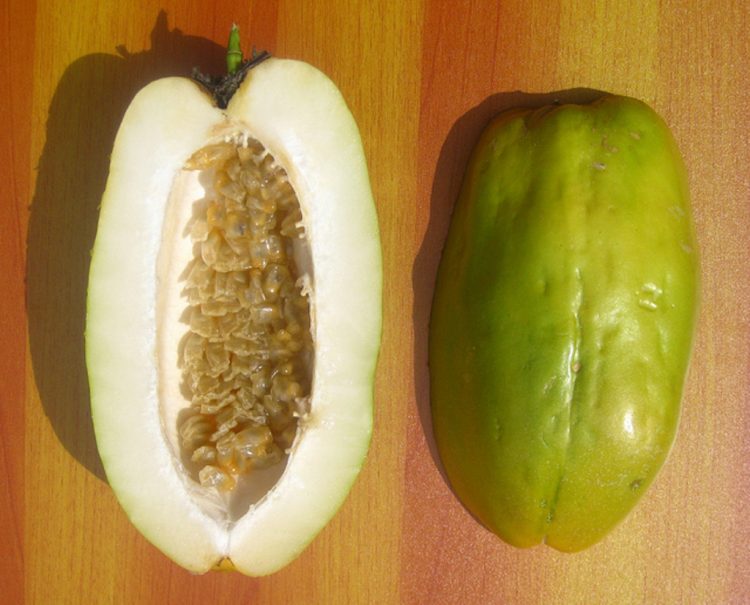
1. Badea
The Badea is part of the Passiflora genus (Passionflower). It is green, ranges from 10-30 centimeters long and 8-16 centimeters wide. It has white, spongy flesh. Also it can tend toward being a little mealy and bland. However, there are hard, flattened seeds in the center which are juicy and used for juice. It is high in calcium, phosphorous, and niacin.

2. Borojó
This round, dark brown fruit is touted as Colombia’s natural Viagra and often sold in juice or jam form, which is said to provide sustained energy due to high levels of B vitamins. It grows in the northwest area of Colombia in the Chocó department.
I tried it at a fruit shop in Los Torres de Bomboná (Cl. 47 #4260, El Centro). And I found it a little bitter but interesting. It is high in phosphorus as well as protein, a rarity for fruit.
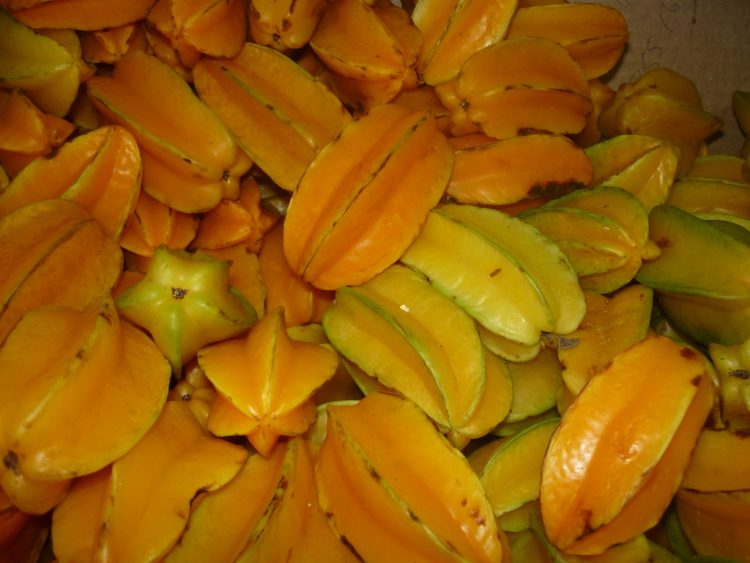
3. Carambolo (a.k.a. Starfruit)
This beautiful star shaped yellow fruit has a waxy exterior and juicy interior. It can be eaten as is – skin and all. For me, the flavor was a cross between an apple and a grape and I liked the crisp texture. Low in calories, high in fiber and vitamin C, macerated carambola can be mixed with aguardiente and left to sit for 45 days to create a delicious liqueur.
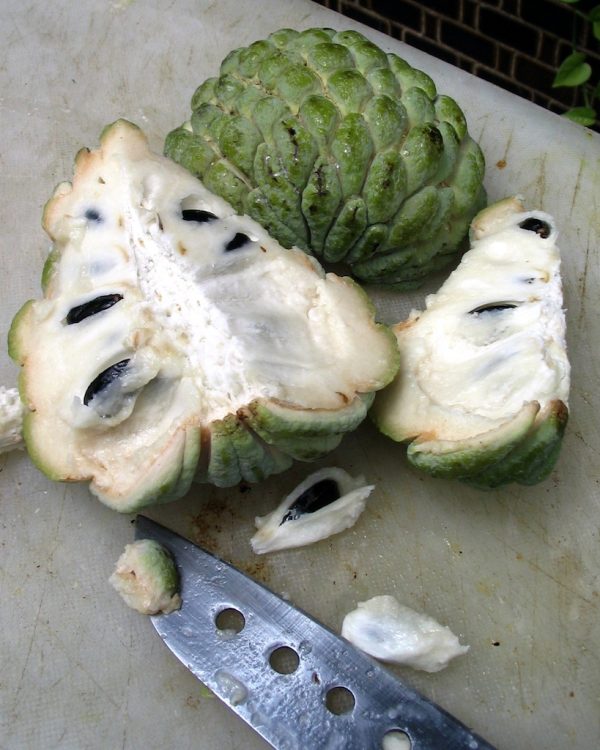
4. Cherimoya (a.k.a. Custard Apple)
This green, heart shaped fruit is covered in layers of tender skin that resemble petals. It has a very soft, creamy and sweet flesh that I ate straight from the fruit. It’s also excellent in smoothies, mousse and pie fillings. The large black seeds are toxic and can actually be used as an insecticide when crushed. It is high in fiber, vitamin C and potassium.
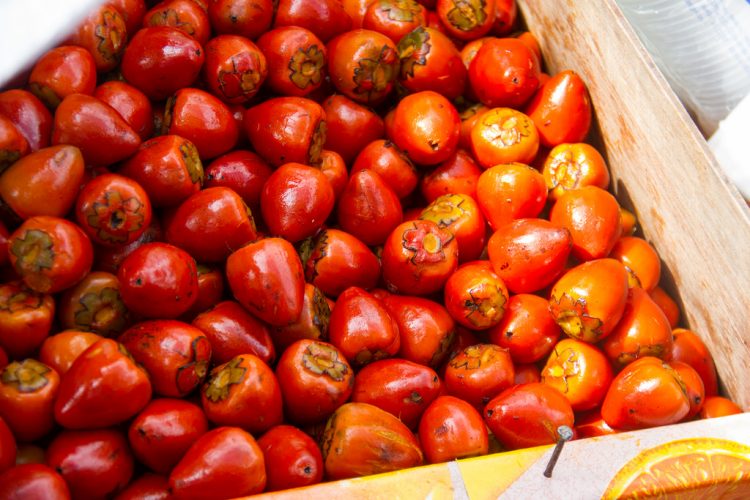
5. Chontaduro
The fruit vendors of El Centro are excellent place to find chontaduro, a small red-orange fruit which is from the Pacific region. This palm fruit contains as much protein as eggs, liposoluble vitamins, zinc, cooper, calcium, iron, beta-carotene and helps lowering cholesterol levels, due to its high contents of omega 3 and 6. Due to extremely hard flesh it needs to be cooked before eating.
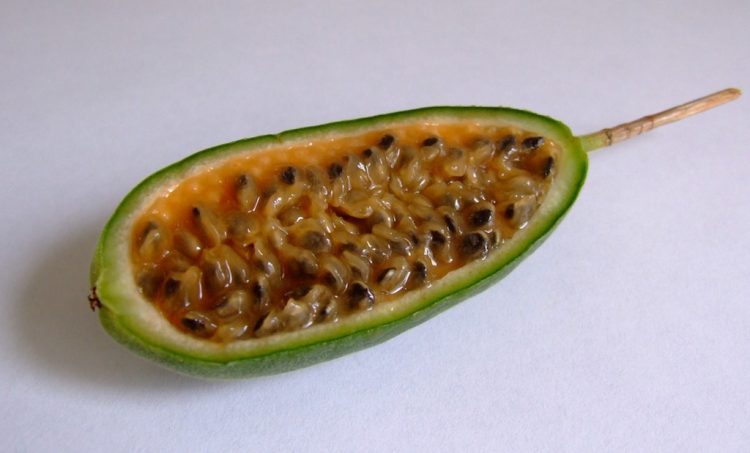
6. Curuba
I found this fruit from the Passiflora genus to be quite bland. It looks a little like a small straight banana. The skin is thin and soft and the inside is full of orange seeds which I scooped out and ate with a spoon. Apparently is it delicious when mixed with milk and sugar. It has a high pectin content and is often used in jams.
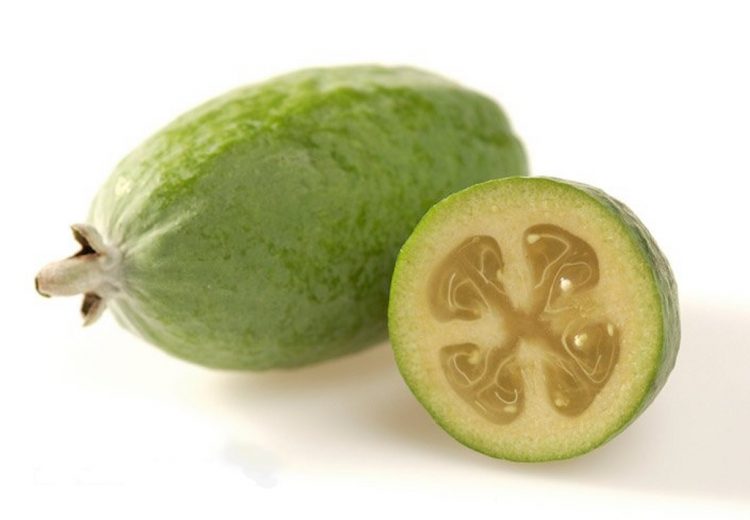
7. Feijoa
A small green ovoid fruit with a thick skin, I found this fruit to smell like flowery perfume. It had the strongest aroma of all the fruits I tried. With creamy soft white flesh inside, I simply scooped out spoonfuls to eat. However, I found the soapy, intense smell and flavor to be unpleasant.

8. Granadilla
Another fruit from the Passiflora genus, this round yellow fruit has a thick, slippery exterior. Inside it is full of edible dark seeds surrounded by pulp. Often used for juices, it can also be eaten fresh and tastes like a mild maracuyá. High in vitamins A, C and K as well as phosphorous, iron and calcium.
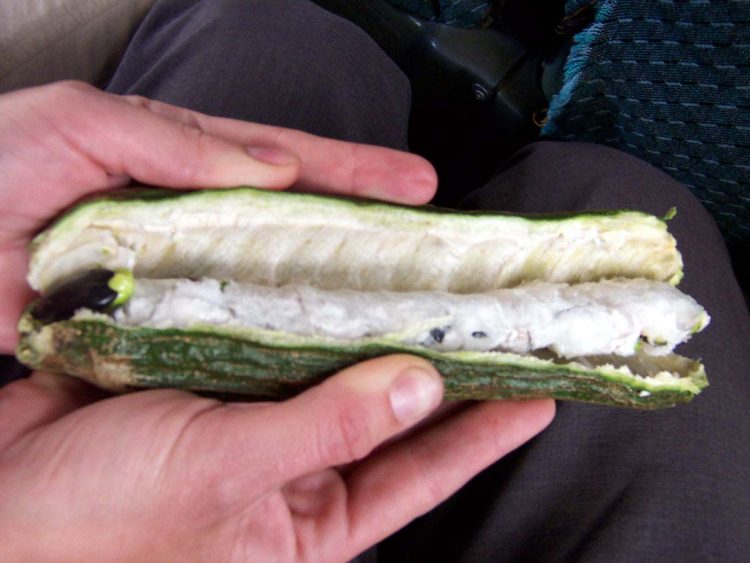
9. Guama (or Guaba)
This is a less common but reportedly delicious fruit that is pretty unique. It’s a pod fruit and guama pods can be as long as your forearm and are bright or dark green in color. When you open a guama you’ll see the fruit that looks like a row of cotton balls, each wrapped around a seed. You eat the white part and spit out the seed.
Guama is reportedly anti-inflammatory and helps to lower blood pressure. I looked and unfortunately couldn’t find a guama in Medellín but still hoping to find one to try.

10. Guanabana
A giant green spiky fruit that can weigh up to four kilograms, the guanábana wins the exotic looking award. I spotted these fruit when I was walking on a trail on the outskirts of Minca (near Santa Marta) and thought they looked amazing. However, for me, the white, juicy flesh has a weird slimy texture I didn’t like. Although not scientifically proven many believe it can assist in curing cancer.
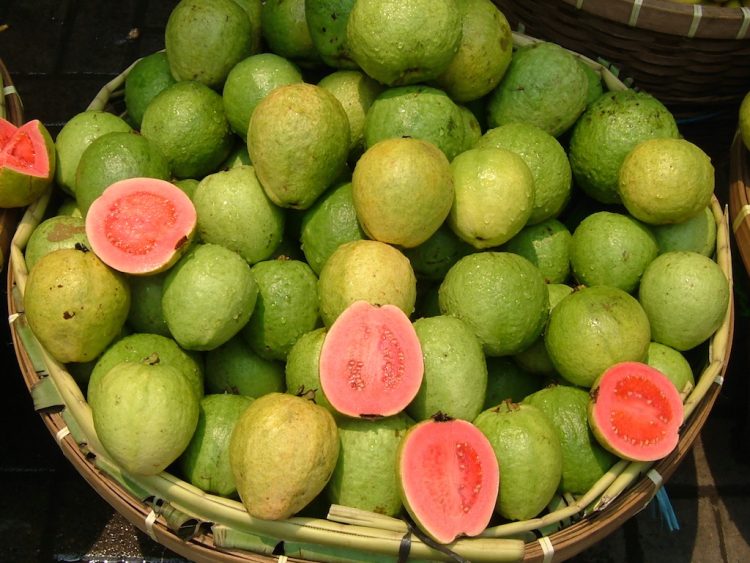
11. Guayaba (Guava)
One of my favorite fruits, the guayaba looks like a small green pear. Cut it open and find a gorgeous pink interior that is fragrant and firm. There are hard little seeds within the flesh but they are edible too. Guayaba is the base for bocadillo, those delicious gelatinous bricks sold everywhere. It is extremely high in vitamin C.
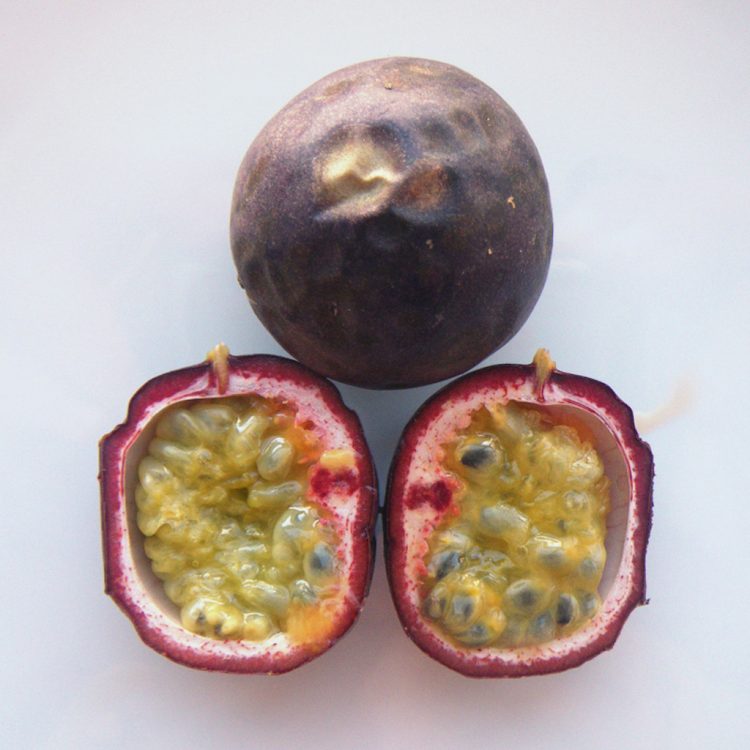
12. Gulupa
Yet another fruit from the Passiflora genus, this passionfruit is purple and has a tough, smooth exterior. Inside are dark seeds covered in gelatinous coating. Slightly sweet, it is best used in juice to bring out its flavor. Like all passionfruit, the gulupa can be used as a natural sedative.
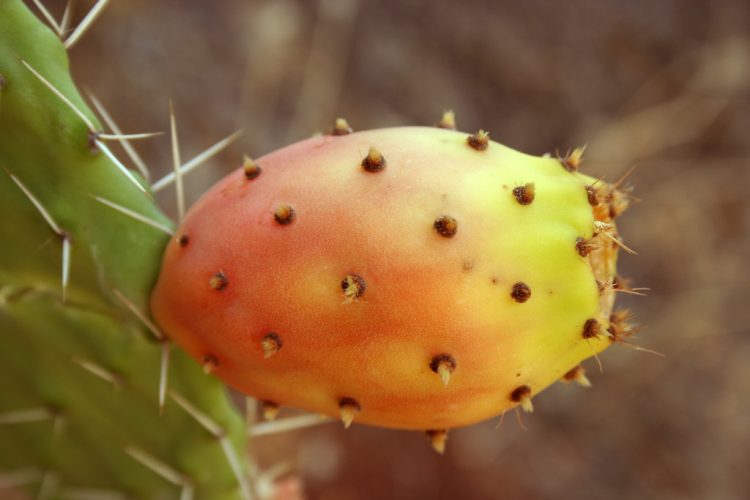
13. Higo
A small green fruit that looks like a cactus (and does indeed grow on a cactus), the higo has a deep orange flesh which is quite watery and bland. There are tiny extremely hard seeds within the flesh that I disliked crunching on.
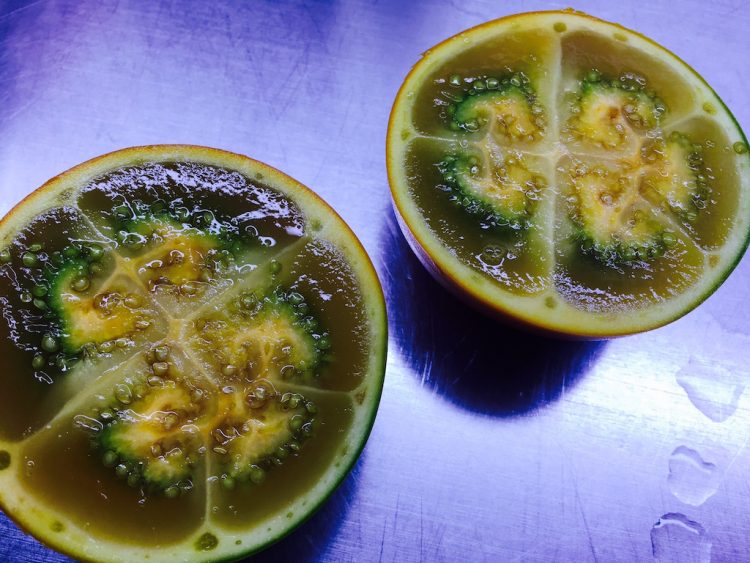
14. Lulo
I adore the lulo. The name, bright orange color, firm translucent interior and pretty seeds are beautiful and unique. Too tart to eat alone, simply scoop out the flesh and blend with ice, lime, water and sugar to make a refreshing drink. In traditional medicine lulo juice is used as a diuretic.
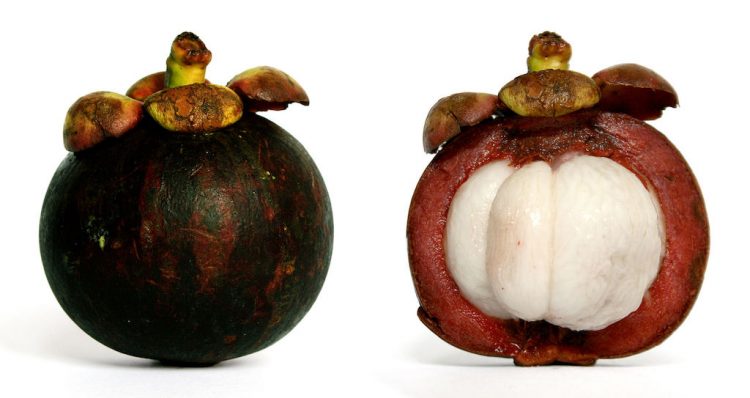
15. Mangosteen
Mangosteen fruit is a unique sweet, juicy and tangy tropical fruit. It has a deep reddish-purple colored rind when its ripens. It grows on an evergreen tree. Natives in Southeast Asia call Mangosteens the “fruit of the gods” and it plays a part in traditional medicine in these cultures.
The Mangosteen contains a class of naturally occurring polyphenol compounds known as xanthones, which are antioxidants. Xanthoneshave been shown to have several benefits, including being used as an anti-inflammatory. Different parts of the fruit and plant are used in the treatment of various diseases and disorders, including cardiovascular diseases, tuberculosis, cancer and Alzheimer’s disease.
Mangosteens are rich in Vitamin C and are also low in calories (only about 63 calories per 100g). The taste of Mangosteen is reportedly a cross between peaches, clementines and mangoes. It is sometimes difficult to find Mangosteens in Colombia as this is reportedly one of the rarest fruits in the world. I was unable to find one before writing this article, but still included it in this list.
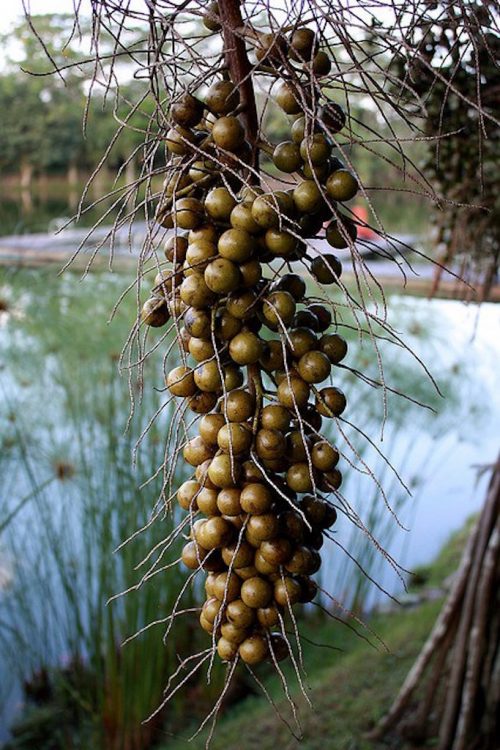
16. Mamoncillo
The fruit is also known as mamón, mamones, quenepa, guinep, limoncillo and several other names. The fruit is somewhat like a cross between a lychee and a lime and it’s tangy and a little sweet. They have a tight and thin, but rigid layer of skin, which are traditionally cracked by the teeth. They grow on a branch and are green in color.
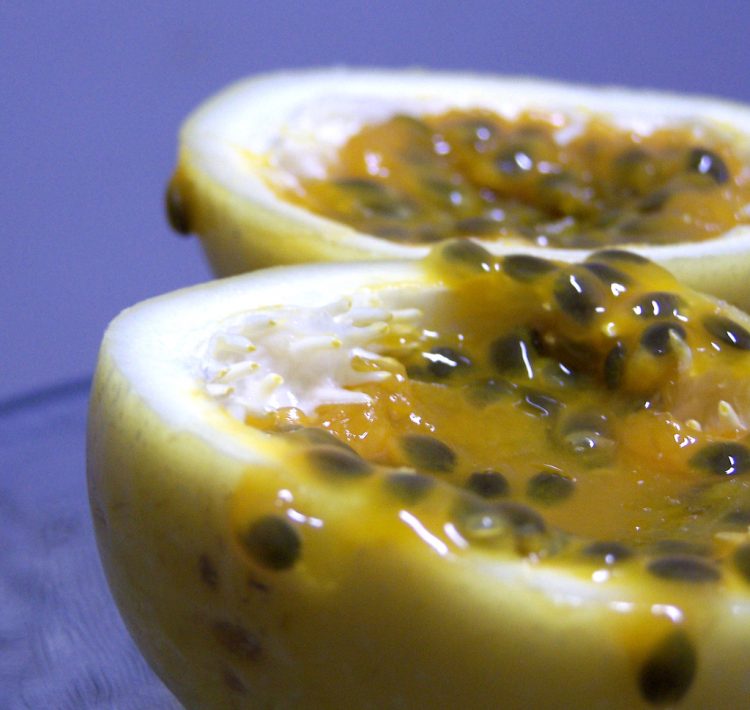
17. Maracuyá
Probably the most well-known fruit from the Passiflora genus, the maracuyá, often referred to as passionfruit, is extremely tart when eaten alone. It has thick yellow skin which becomes wrinkled when ripe. I like cutting off the very top, sprinkling sugar inside and mixing it up with the seeds and eating it by the spoonful. The thick skin makes a perfect biodegradable cup. Mostly though, it is used to make delicious juice.
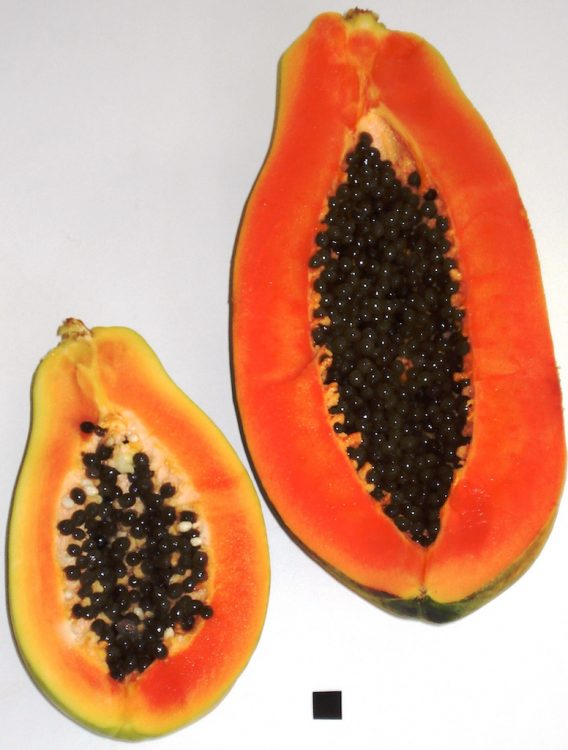
18. Papaya
Another one of my favorite fruits, the papaya has a love it or hate it flavor for many people. It grows in abundance, can weigh anywhere from one to 20 pounds, and the tiny black seeds are said to be effective in getting rid of intestinal parasites. The firm flesh is a gorgeous orange color and I love eating it cubed by the bowlful. It is the basis for the beloved Colombian snack ‘salpicón,’ basically fruit salad swimming in pureed papaya.

19. Pitahaya
Also known as dragonfruit, probably because the thick yellow scales resemble those of a dragon, this fruit is considered native to Colombia. Inside, the firm white flesh is flecked with tiny black seeds. The skin easily peels away and the interior can be sliced. I thought it tasted like a kiwi. Highly recommended.
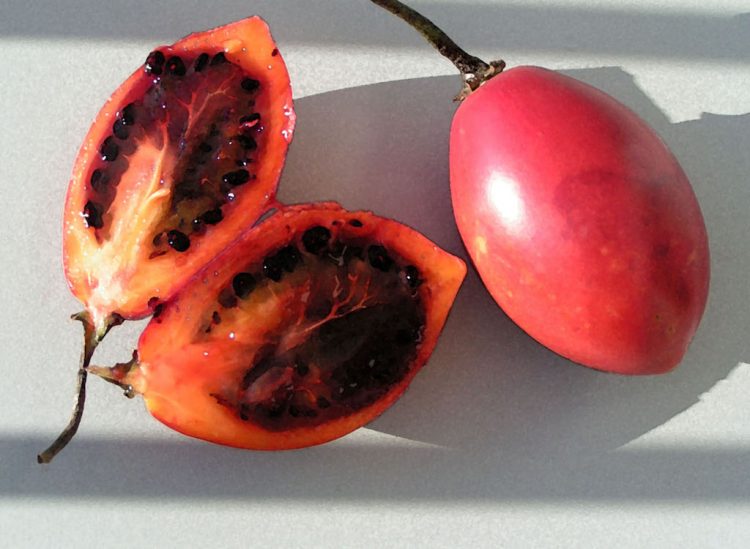
20. Tomate de Arbol
The skin is smooth, red or orange at maturity, with light colored streaks. The flesh is orange and juicy, slightly acidic, with numerous seeds. Although mostly used to make juice (a popular juice offered with the ‘menú del día’), it can also be eaten alone, or sprinkled with salt.
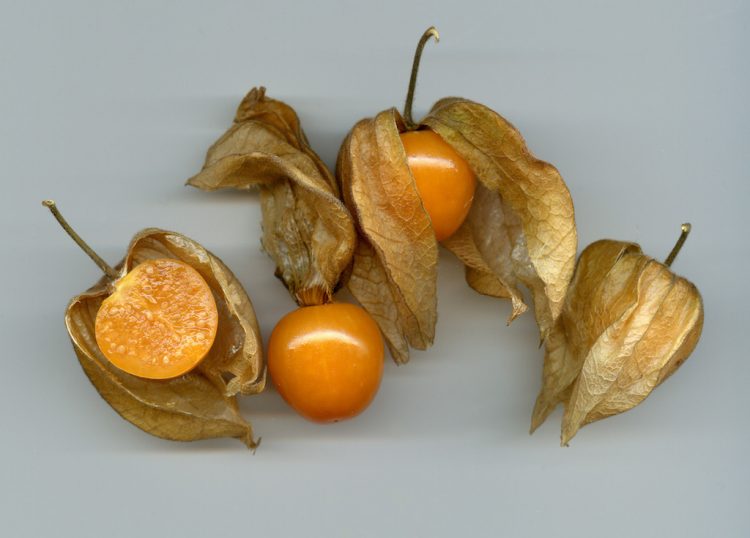
21. Uchuva
Can I have another favorite? I first tried uchuva when I visited the market at Parque Arví. The small, round, bright orange fruit caught my eye and when it was offered to me drizzled in chocolate I bought it immediately. It has a sweet tart flavor and a texture similar to a cherry.
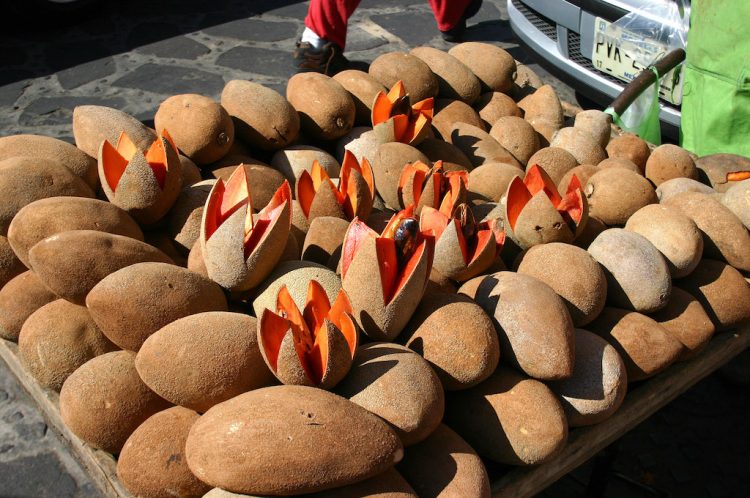
22. Zapote
A round brown fruit whose skin has a texture somewhere between sandpaper and peach fuzz. Inside the flesh is creamy, dark orange and soft with two massive black seeds. I spit out my first bite, finding the flavor disgusting. However, it is a popular fruit that is often made into milkshakes, smoothies and ice cream. The addition of dairy probably softens the strong flavor.
The Bottom Line – Tropical Fruits of Colombia
There are a tremendous number of tropical fruits available in Colombia. You can find many at your local grocery stores. But to find some you may have to go to a market like Minorista, which has a bigger selection.
Are we missing any exotic tropical fruits of Colombia in our updated list?
How many have you tried and what’s your favorite Colombian fruit?
 About Sonja
About Sonja
Sonja is from Whidbey Island, WA. She has traveled to 46 countries but never wanted to settle down in any of them until she discovered Medellin. She is currently living here in Medellín temporarily until she figures out how to be a permanent resident.
Reminder: Join our Medellín Living June Meetup on June 8 at 7pm at Sport Wings located at Mayorca mall in Sabaneta. This meetup is a good way to meet other expats like Sonja living in Medellín as well as newcomers visiting or considering moving to the city.

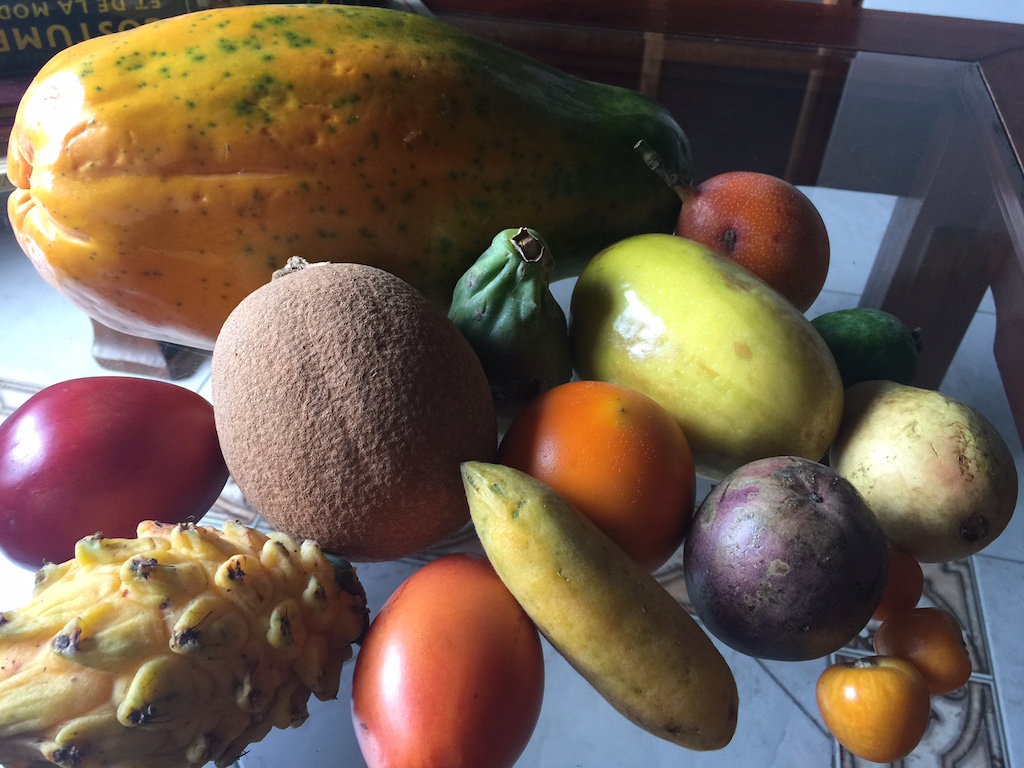

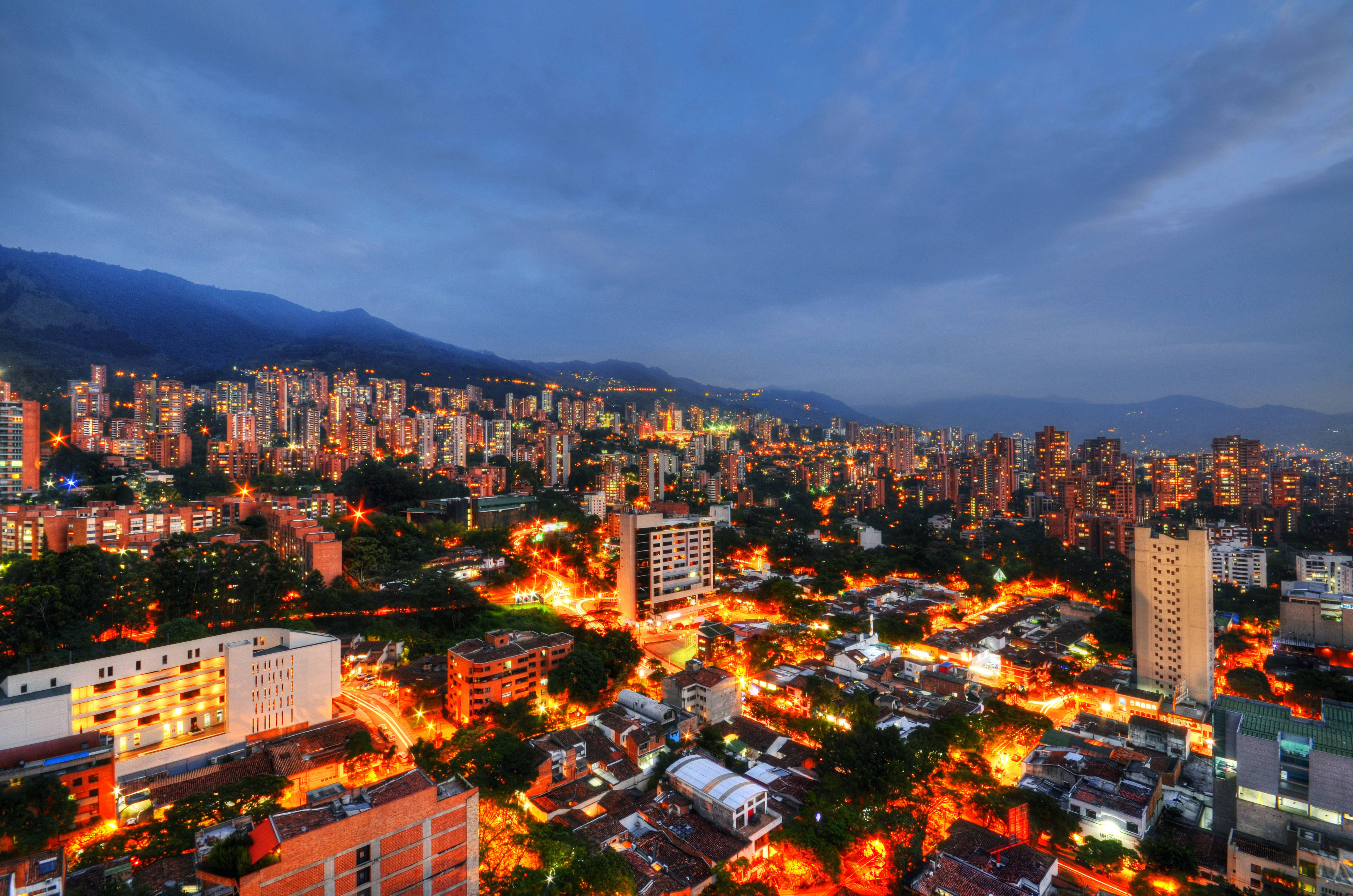








Yummy article, thanks Sonja!
Beware that many of the fruits may cause diarrhea to sensitive people (like me). I eat them only on a non-empty stomach and just a small portion. The pitaya is used by Paisas exactly for that…
Nice article. I have tried almost all of these.
One you are missing is banano bocadillo also known as lady finger bananas. They are smaller, sweeter and thinner skinned than regular bananas. And they don’t ripen as fast. You can find them sometimes in the big grocery stores like Exito and also the Minorista market and many small fruit vendors.
Kate, thanks for the kind words and mentioning the banano bocadillo. I can’t believe I forgot to include it since I bought some just last week at Carulla. Yet another delicious fruit!
I have eaten the carambolo in the US and in Medellin. A female friend from Panama told me they consider this fruit as their Viagra fruit. I saw no special effects. Also make sure you find them fully ripen for best tatse. If not, they can be bitter.
Sonja – Great, thorough article! I still need to try Higo, Guama, Badea, and Curuba to complete the list! Bummed you haven’t had the pleasure of trying mangosteens yet. Along with a cold, ripe, cherimoya, they are my favorite. The season passed about two months ago where you could easily find in Carulla or street vendors. Next season only a few months away I imagine. My word of advice: only buy one’s that are still slightly soft to the touch, you should be able to pierce the skin with your fingernail, and (as with avocados) the heavier it feels in your hand the better. More than a few times I purchased a bag from a vendor only to find most rotten/bitter, and learned my lesson.
Exelente article. Can not wait to March to be in Madallin.
But if mangosteens growing in Colombia, which are planty of them in S.E. Asia so durian should be find as well in Colombia.??
Like everyone reading this article I also enjoy the wide variety of fruits, and this list is pretty comprehensive. Although, it is missing one I found this last trip… agraz, which is a small red berry about the size of a pencil eraser. I found translations online as an unripe grape, or a red currant. But, it actually seems more like a black currant. A tart little fruit, goes good on a bowl of granola.
I found agraz in a few markets including Carulla, and the chain of fruit markets “surtifruver” (some of these stores are small and don’t carry a wide variety of fruits as larger locations do). Regardless, the fruit was generally in a refrigerated cooler in small plastic bags about 3×4 inches.
Another I have not found yet is papayuela. There is a flea/farmers/craft market in the Usaquen area of Bogota on Sundays, and one lady sells jams made from most of the fruits above, including papayuela. So, if you can’t find a fruit above, her jams will give you a good taste (and she gives free samples).
There is also Yacon which is actually a tuber veggie, but it is sweet like a fruit, but more the consistency of crisp apple with a very mild flavor.
Also, you can request a few of these fruits in this article in the USA if you have a local grocer who can order from a specialty fruit supplier. (My father was one of these grocers for decades.) Feijoa is actually grown in CA in some places if you are lucky enough to find it. And, if you are in Boyaca in Colombia, be sure to try Feijoa Liquor or “Sabajon de Feijoa”.
In Parque Arvi (Medellin), there is a stand that also sells a bottled mushroom beer… go early to get it. They sell grilled mushrooms for lunch. The day I went the beer had sold out already, but they had other microbrew available. 🙁
Nispero and Zapote (zapote costeño, which is way different and smother, from the Caribbean) are probably my favorites. Also Acerola, Copoazu from the Amazon are delicious.
Very nicely done! So fun to relive memories from my many trips as a young child until I was 19 to Colombia. I loved all the different exotic fruits! I very much enjoyed the curuba smoothie/ shakes they made me Well to be honest I loved everything! Special wonderful memories! I’d like to visit again..I still have family there.👍🍒
Mora is probably not considered an exotic fruit but I will put it in the list. When I came to leave in USA I bought black berry thinking it was mora despite the darker color and was very disappointed. I now find it frozen or pulp but is never the same as buying it at the fresh market as I use to do in Bogota.
Great article.Higo also known as “Tuna” makes a wonderful magente juice that is tart when juiced. It makes a brilliant pink jelly or special addition to cocktails.
I was just talking about guama (ice cream bean in English) on a coffee finca tour in Cauca. The owner and several locals told me they aren’t often sold in markets and your more likely to find them in a forest or “wild” yard. When I had some it was from my brother-in-law’s yard. Good luck finding it. The texture is bizarre.
The zapote (Pouteria sapota) is delicious. Also called Mamey, Mamey Zapote, & various other local names.
I have also cooked it with cookies, cake, & bread.
It is quite rich in flavor and sickeningly sweet. Raw it is an intensely sweet soft flesh that most can only take a bit of. My solution is not to eat it raw, but instead to use it in things I would normally find pumpkin or custard type fillings.
All in all a good article. I would hope you would find the botanical names to include with your articles so people can learn more about the fruits on their own.
Great list of tropical fruits in Colombia. I have been to Medellin twice and loved it. Will visit again in the future.
You’re making me miss my daily lulu/maracuya juices and avacates for 20 cents!